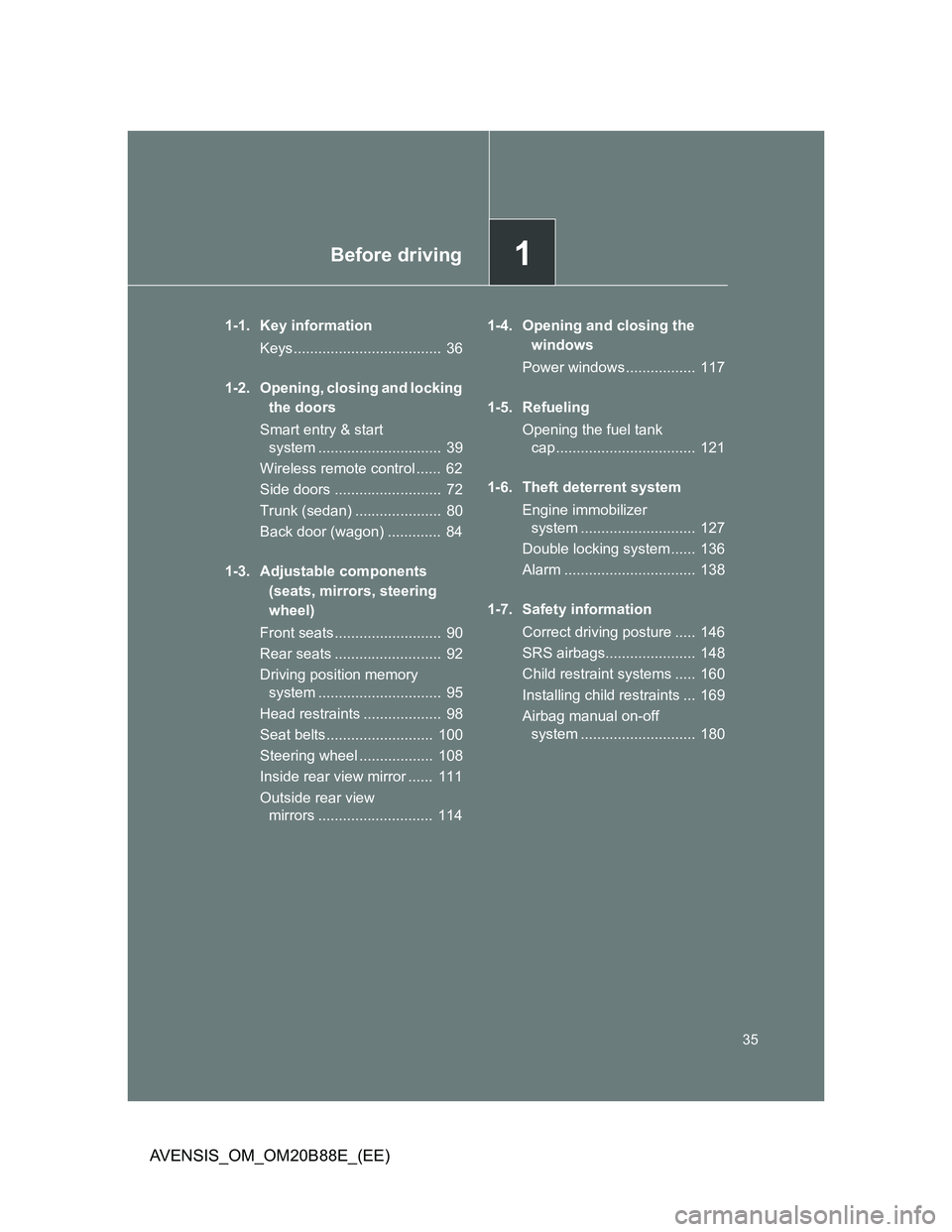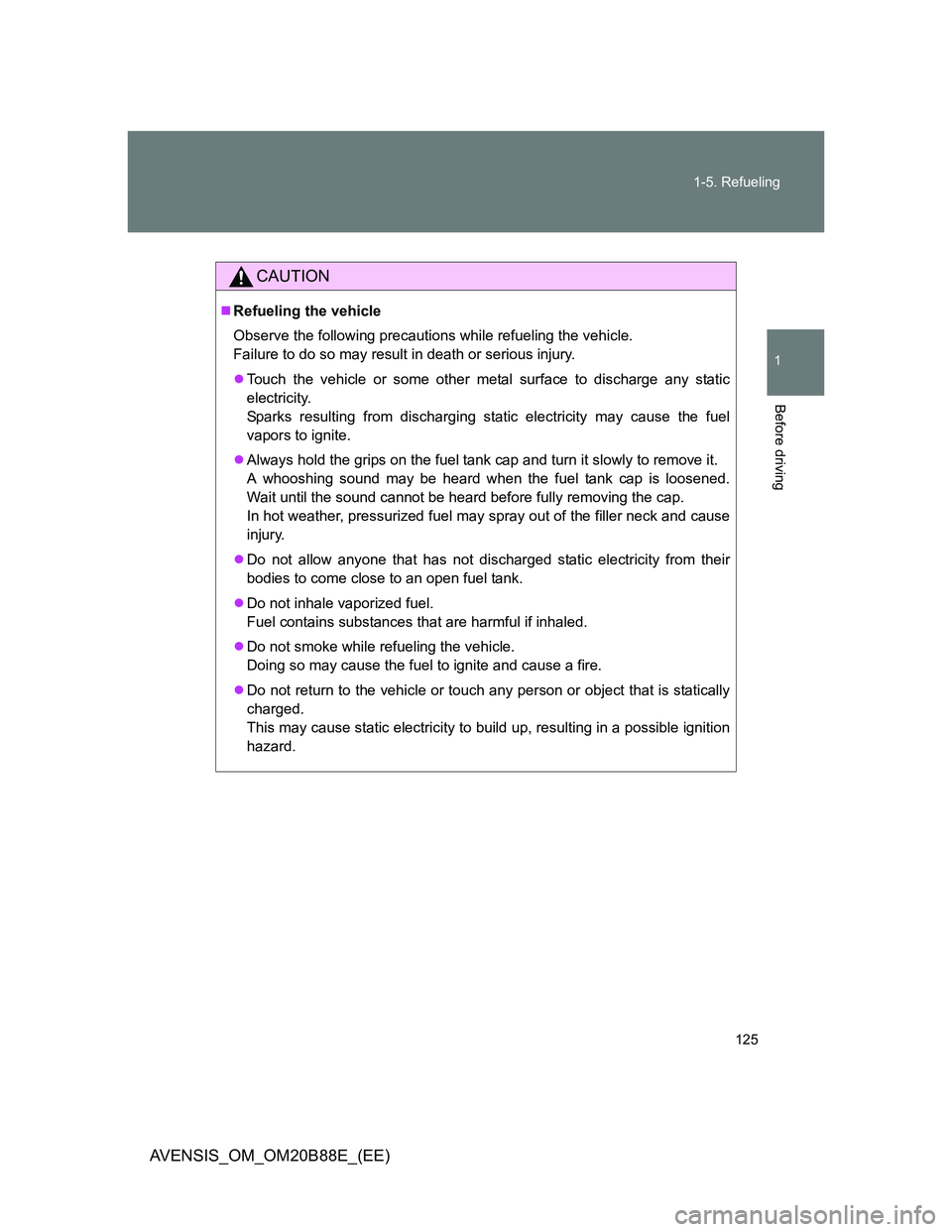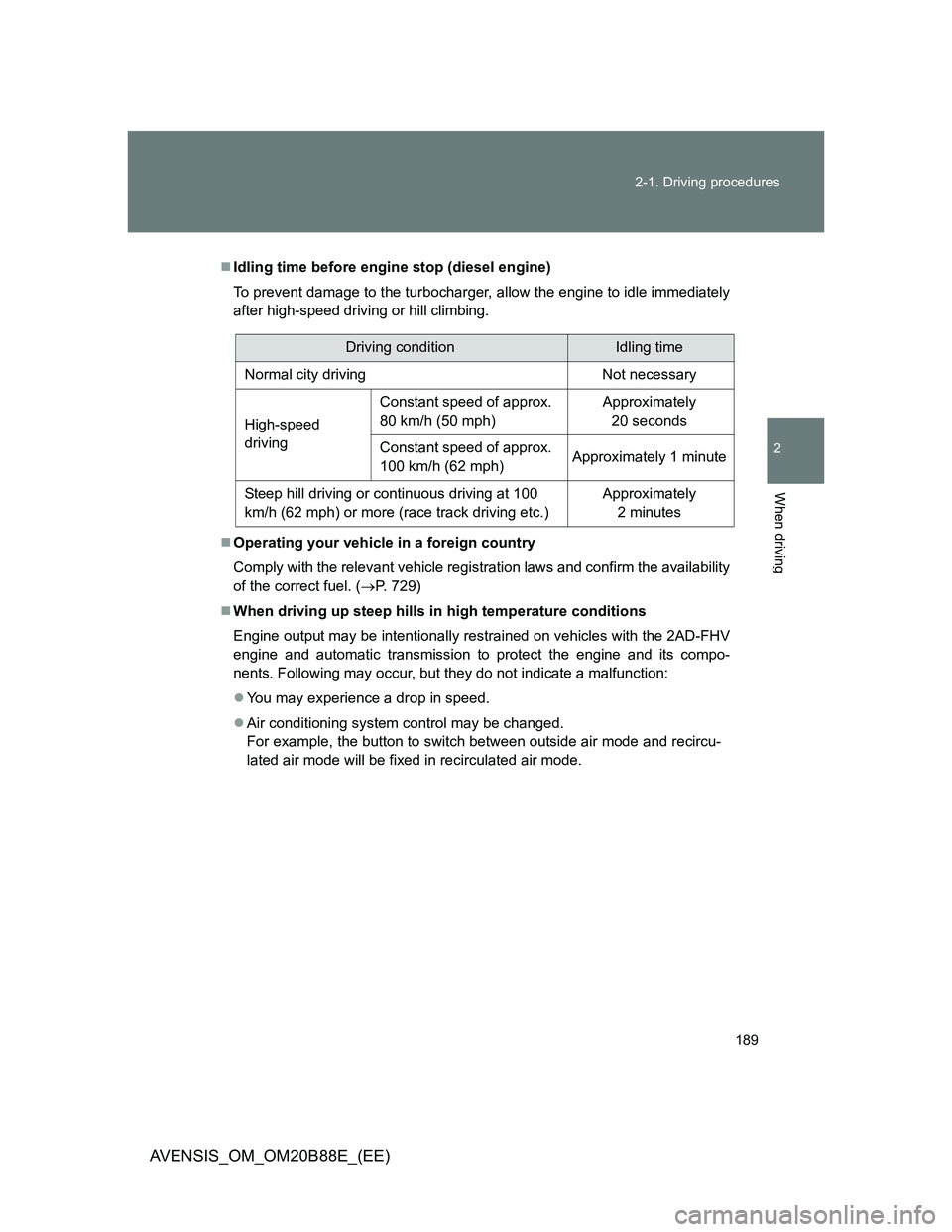Page 35 of 776

1Before driving
35
AVENSIS_OM_OM20B88E_(EE)
1-1. Key information
Keys.................................... 36
1-2. Opening, closing and locking
the doors
Smart entry & start
system .............................. 39
Wireless remote control ...... 62
Side doors .......................... 72
Trunk (sedan) ..................... 80
Back door (wagon) ............. 84
1-3. Adjustable components
(seats, mirrors, steering
wheel)
Front seats.......................... 90
Rear seats .......................... 92
Driving position memory
system .............................. 95
Head restraints ................... 98
Seat belts.......................... 100
Steering wheel .................. 108
Inside rear view mirror ...... 111
Outside rear view
mirrors ............................ 1141-4. Opening and closing the
windows
Power windows ................. 117
1-5. Refueling
Opening the fuel tank
cap .................................. 121
1-6. Theft deterrent system
Engine immobilizer
system ............................ 127
Double locking system ...... 136
Alarm ................................ 138
1-7. Safety information
Correct driving posture ..... 146
SRS airbags...................... 148
Child restraint systems ..... 160
Installing child restraints ... 169
Airbag manual on-off
system ............................ 180
Page 121 of 776
121
1
Before driving
AVENSIS_OM_OM20B88E_(EE)
1-5. Refueling
Opening the fuel tank cap
Perform the following steps to open the fuel tank cap.
Before refueling the vehicle
Vehicles with smart entry & start system
Turn the “ENGINE START STOP” switch OFF and ensure that
all the doors and windows are closed.
Vehicles without smart entry & start system
Turn the engine switch to the “LOCK” position and ensure that
all the doors and windows are closed.
Opening the fuel tank cap
Press the fuel filler door
opener switch.
Turn the fuel tank cap slowly
to open.
STEP1
STEP2
Page 122 of 776
122 1-5. Refueling
AVENSIS_OM_OM20B88E_(EE)
Closing the fuel tank cap
When replacing the fuel tank
cap, turn it until a clicking sound
is heard.
After releasing your hand, the cap
will turn slightly to the opposite
direction.
Hang the fuel tank cap on the
back of the fuel filler door.STEP3
Page 123 of 776
123 1-5. Refueling
1
Before driving
AVENSIS_OM_OM20B88E_(EE)
Fuel types
Gasoline engine
EU area:
Unleaded gasoline conforming to European standard EN228, Research
Octane Number of 95 or higher
Except EU area:
Unleaded gasoline, Research Octane Number of 95 or higher
Diesel engine
Engine/catalytic converterTy p e
1AD-FTV engine without DPF
catalytic converterEU area:
Diesel fuel conforming to European
standard EN590
Except EU area:
Diesel fuel that contains 500 ppm or
less of sulfur and has a cetane number
of 48 or higher
1AD-FTV engine with DPF
catalytic converter, 2AD-FTV
and 2AD-FHV enginesEU area:
Diesel fuel conforming to European
standard EN590
Except EU area:
Diesel fuel that contains 50 ppm or less
of sulfur and has a cetane number of
48 or higher
Page 124 of 776
124 1-5. Refueling
AVENSIS_OM_OM20B88E_(EE)
Use of ethanol blended gasoline in a gasoline engine
Toyota allows the use of ethanol blended gasoline where the ethanol content
is up to 10%. Make sure that the ethanol blended gasoline to be used has a
Research Octane Number that follows the above.
Fuel tank capacity
Approximately 60 L (15.9 gal., 13.2 Imp.gal.)
When the fuel filler door opener switch is inoperable
Pull the lever slowly rearward (not side-
ways) as shown in the illustration.
The lever can be used to open the fuel
filler door if the fuel filler door cannot be
opened using the inside switch because
the battery discharged or for any other
reason.
Page 125 of 776

125 1-5. Refueling
1
Before driving
AVENSIS_OM_OM20B88E_(EE)
CAUTION
Refueling the vehicle
Observe the following precautions while refueling the vehicle.
Failure to do so may result in death or serious injury.
Touch the vehicle or some other metal surface to discharge any static
electricity.
Sparks resulting from discharging static electricity may cause the fuel
vapors to ignite.
Always hold the grips on the fuel tank cap and turn it slowly to remove it.
A whooshing sound may be heard when the fuel tank cap is loosened.
Wait until the sound cannot be heard before fully removing the cap.
In hot weather, pressurized fuel may spray out of the filler neck and cause
injury.
Do not allow anyone that has not discharged static electricity from their
bodies to come close to an open fuel tank.
Do not inhale vaporized fuel.
Fuel contains substances that are harmful if inhaled.
Do not smoke while refueling the vehicle.
Doing so may cause the fuel to ignite and cause a fire.
Do not return to the vehicle or touch any person or object that is statically
charged.
This may cause static electricity to build up, resulting in a possible ignition
hazard.
Page 126 of 776
126 1-5. Refueling
AVENSIS_OM_OM20B88E_(EE)
CAUTION
When replacing the fuel tank cap
Do not use anything but a genuine Toyota fuel tank cap designed for your
vehicle. Failure to do so may cause a fire or other incident which may result
in death or serious injury.
NOTICE
Refueling
Do not spill fuel during refueling.
Failure to do so may damage the vehicle, such as causing the exhaust sys-
tems to operate abnormally or damaging fuel system components or the
vehicle’s painted surface.
Fuel filler door emergency release lever
Do not pull the lever strongly.
Do not use the lever except in an emergency.
Page 189 of 776

189 2-1. Driving procedures
2
When driving
AVENSIS_OM_OM20B88E_(EE)
Idling time before engine stop (diesel engine)
To prevent damage to the turbocharger, allow the engine to idle immediately
after high-speed driving or hill climbing.
Operating your vehicle in a foreign country
Comply with the relevant vehicle registration laws and confirm the availability
of the correct fuel. (P. 729)
When driving up steep hills in high temperature conditions
Engine output may be intentionally restrained on vehicles with the 2AD-FHV
engine and automatic transmission to protect the engine and its compo-
nents. Following may occur, but they do not indicate a malfunction:
You may experience a drop in speed.
Air conditioning system control may be changed.
For example, the button to switch between outside air mode and recircu-
lated air mode will be fixed in recirculated air mode.
Driving conditionIdling time
Normal city driving Not necessary
High-speed
drivingConstant speed of approx.
80 km/h (50 mph)Approximately
20 seconds
Constant speed of approx.
100 km/h (62 mph)Approximately 1 minute
Steep hill driving or continuous driving at 100
km/h (62 mph) or more (race track driving etc.)Approximately
2 minutes